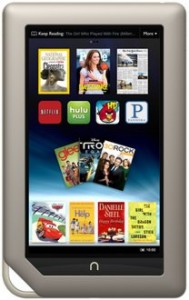 The competition in the 7″ Tablet market was obviously thrown into disarray by the arrival of the Amazon Kindle Fire and Barnes & Noble Nook Tablet devices. Even if you completely set aside the service being offered in conjunction by either company, any moderately powerful Android Tablet in the $200-250 range is attractive. Just look at how well the Nook Color did, even locked down with ridiculously few apps and a marketing campaign focused on reading. What’s also rather clear, however, is that with the Kindle Fire getting the majority of the attention pre-launch, B&N needed to make an impression on potential customers. They may have overdone it a bit.
The competition in the 7″ Tablet market was obviously thrown into disarray by the arrival of the Amazon Kindle Fire and Barnes & Noble Nook Tablet devices. Even if you completely set aside the service being offered in conjunction by either company, any moderately powerful Android Tablet in the $200-250 range is attractive. Just look at how well the Nook Color did, even locked down with ridiculously few apps and a marketing campaign focused on reading. What’s also rather clear, however, is that with the Kindle Fire getting the majority of the attention pre-launch, B&N needed to make an impression on potential customers. They may have overdone it a bit.
The most obvious disappointment for Nook Tablet early adopters was the storage space. One of the biggest draws in this case was the fact that they included twice the Kindle Fire’s storage space. This is especially important given the huge emphasis on video viewing that’s been happening lately. The Nook certainly offers more natively supported formats, so 12GB of available space to side load your library onto is great on paper. As we’ve learned since then though, that’s not going to be happening. Barnes & Noble decided that Nook Tablet owners would probably be needing to have around 11GB of that space blocked to outside content. That’s less than 10% of what was promised, which means that the only people likely to ever get the most out of their new Nooks in this regard are the ones who root them.
Also related to the video viewing qualifications of the device is the quality problem. Probably to set themselves apart from the Kindle Fire yet again, B&N advertised the new Nook as “The best in HD entertainment”, among a number of other similar claims. Now, obviously this could not be the case. Anybody who gave it a decent amount of thought already knew that, given the resolution of the screen if nothing else. This sort of language has since been dropped from the Nook Tablet product page. Here you can read more about how to open HEIC file
The official response was that what they “really” meant for customers to understand was that they pull a higher quality video feed from Netflix than the competition and the message just got lost in translation somewhere. Where the Kindle Fire pulls the standard definition stream and fits it to the tablet, the Nook Tablet grabs the HD and downgrades it. This does, admittedly, result in a better picture for those with the network reliability to support it and would have made sense to advertise. Instead, they opted for what seems to have been deliberate misinformation.
It’s taken a bit of time, but corrections are being made to the advertising. I think it’s important to make note of these early efforts to drum up preorders, though. While the Nook Tablet is definitely a good product for the money, there’s something a bit off about this approach to selling it. There is a big difference between fixing launch bugs and having to significantly modify your product descriptions to avoid deceiving customers.
No need to root. The Nook has an SD Card Slot that can hold up to 32GB cards so anyone wanting to “make the most of it” with outside content just has to slap in a card – or multiple cards. If they don’t have one on hand for less than $15 they could add 16gb or for less than $10 8 GB which would give them more space than the approx 6 GB not 8GB of internal storage space the Kindle Fire gives – that can never be expanded.
But you might say Amazon has the “cloud” and offers 5GB of space for non Amazon stuff and more space for more $$$$. Yes but Amazon neglected to say you can’t stream anything from it except mp3s. Everything else has to be downloaded fully to that 6GB of on storage space. So what exactly is the point of uploading videos, photos or documents to the cloud in the first place? Those who bought addition cloud space for their content for anything but mp3 were out of luck and money.
Funny how a consumer needing a fast enough internet connection to appreciate the Nook’s HD feed from Netflix is a slam on the advantage (which was actually explained on the product page of the Nook quite well for any one with a minimum of technical comprehension skills). But the huge crutch on the cloud by The Fire for streaming all content and having a good enough connection to do so is seen a as plus – so much so Amazon can’t be bothered to even add a USB cord to transfer files from the computer to the Fire. (which will cost about what 8GB SD card will to add more space to the Nook)
I wonder if you’d consider any of that “misleading” Kindle advertising? Not to mention the promised supposedly fast but slower than molasses and any other no frills android browser that seemingly exists just to collect data from all the Kindle owners.